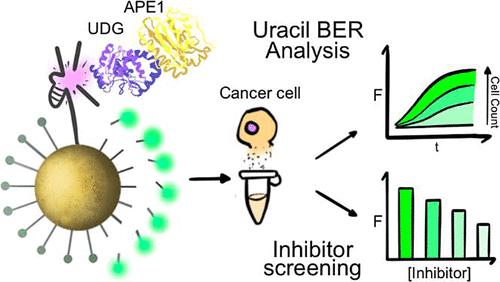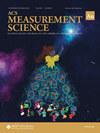利用三维 DNAzyme Walker 检测癌症细胞样本中的尿嘧啶-切除 DNA 糖基化酶
IF 4.6
Q1 CHEMISTRY, ANALYTICAL
引用次数: 0
摘要
DNA 糖基化酶失调与癌症的发生和抗药性有关。因此,人们利用 DNA 糖基化酶的碱基切除活性,开发了各种基于 DNA 的检测平台。然而,由于癌细胞中常见的核酸酶以及细胞裂解液制备过程中的非特异性降解,基于 DNA 的方法的有效性受到了影响。在本报告中,我们介绍了一种基于荧光的检测方法,利用特异性和抗核酸酶的三维 DNA 酶步行器来研究癌细胞裂解液中 DNA 糖基化酶的活性。我们重点研究了从脱氧尿苷(dU)病变中切除尿嘧啶的 DNA 糖基化酶,即尿嘧啶 DNA 糖基化酶(UDG)和单链单功能尿嘧啶 DNA 糖基化酶(SMUG1)。在缓冲液中检测 UDG 和 SMUG1 的检测限分别为 3.2 和 3.0 pM。DNAzyme walker 在稀释的 A549 癌细胞裂解物中检测到了尿嘧啶切除活性。UDG 抑制剂实验的结果表明,UDG 是 A549 细胞中最主要的尿嘧啶切除糖基化酶。每个 A549 细胞中平均存在约 500 nM 的 UDG。缺乏 DNA 酶活化的样本不会产生荧光,这表明没有非特异性核酸酶干扰。DNA 酶步行器对糖基化酶活性的反应能力说明了 DNA 酶步行器技术在监测和研究涉及糖基化酶的生化过程方面的潜在用途。本文章由计算机程序翻译,如有差异,请以英文原文为准。

Detection of Uracil-Excising DNA Glycosylases in Cancer Cell Samples Using a Three-Dimensional DNAzyme Walker
DNA glycosylase dysregulation is implicated in carcinogenesis and therapeutic resistance of cancers. Thus, various DNA-based detection platforms have been developed by leveraging the base excision activity of DNA glycosylases. However, the efficacy of DNA-based methods is hampered due to nonspecific degradation by nucleases commonly present in cancer cells and during preparations of cell lysates. In this report, we describe a fluorescence-based assay using a specific and nuclease-resistant three-dimensional DNAzyme walker to investigate the activity of DNA glycosylases from cancer cell lysates. We focus on DNA glycosylases that excise uracil from deoxyuridine (dU) lesions, namely, uracil DNA glycosylase (UDG) and single-stranded monofunctional uracil DNA glycosylase (SMUG1). The limits of detection for detecting UDG and SMUG1 in the buffer were 3.2 and 3.0 pM, respectively. The DNAzyme walker detected uracil excision activity in diluted cancer cell lysate from as few as 48 A549 cells. The results of the UDG inhibitor experiments demonstrate that UDG is the predominant uracil-excising glycosylase in A549 cells. Approximately 500 nM of UDG is present in each A549 cell on average. No fluorescence was generated in the samples lacking DNAzyme activation, indicating that there was no nonspecific nuclease interference. The ability of the DNAzyme walker to respond to glycosylase activity illustrates the potential use of DNAzyme walker technology to monitor and study biochemical processes involving glycosylases.
求助全文
通过发布文献求助,成功后即可免费获取论文全文。
去求助
来源期刊

ACS Measurement Science Au
化学计量学-
CiteScore
5.20
自引率
0.00%
发文量
0
期刊介绍:
ACS Measurement Science Au is an open access journal that publishes experimental computational or theoretical research in all areas of chemical measurement science. Short letters comprehensive articles reviews and perspectives are welcome on topics that report on any phase of analytical operations including sampling measurement and data analysis. This includes:Chemical Reactions and SelectivityChemometrics and Data ProcessingElectrochemistryElemental and Molecular CharacterizationImagingInstrumentationMass SpectrometryMicroscale and Nanoscale systemsOmics (Genomics Proteomics Metabonomics Metabolomics and Bioinformatics)Sensors and Sensing (Biosensors Chemical Sensors Gas Sensors Intracellular Sensors Single-Molecule Sensors Cell Chips Arrays Microfluidic Devices)SeparationsSpectroscopySurface analysisPapers dealing with established methods need to offer a significantly improved original application of the method.
 求助内容:
求助内容: 应助结果提醒方式:
应助结果提醒方式:


